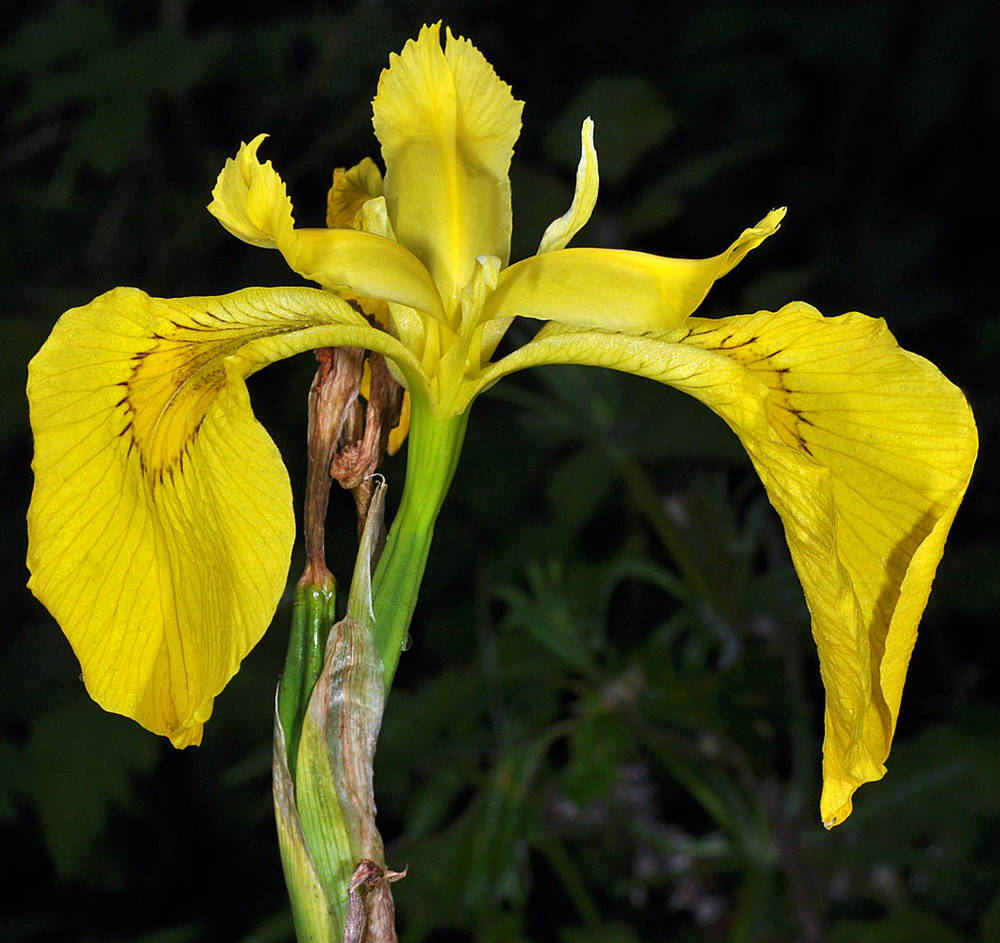Iris pseudacorus
Iris germanica
yellow flag, yellow water iris
bearded iris, garden iris, German iris
fleshy;
rhizomes pink, freely branching, producing extensive clumps with remains of old leaves.
fleshy;
rhizomes homogeneous; many-branched.
usually 1-branched.
branched.
deciduous; stiff; erect at first then recurved;
blades dark green with prominent median thickening, 20–30 mm wide;
cauline leaves equal in height to inflorescence.
unifacial; sword-shaped, 3.5 cm wide, forming an obvious fan.
4–12-flowered;
bracts subequal, green with brown margins; outer bract strongly keeled.
1–3-flowered;
bracts green, sometimes with a purple base.
perianth bright yellow or cream; signal a darker yellow basal patch delimited by short, brown lines;
petals without veining;
tube 12–13 mm;
stigmas rounded with prominent tongue.
perianth blue-violet, yellow, brown, or white with various patterns of color;
sepals with beard along midrib of claw and lower part of limb;
petals erect.
angled, with obvious groove at each angle.
roundly 3-lobed.
D-shaped, flattened; corky, lustrous.
red-brown, wrinkled.
=24, 30, 32, 34.
Iris pseudacorus
Iris germanica
Swamps, wet shores of rivers and lakes, irrigation ditches. Flowering May–Jun. 0–1000 m. BW, CR, Est, Lava, WV. CA, ID, NV, WA; throughout North America; northern Africa, Eurasia. Exotic.
A native to Eurasia and Africa, this taxon is considered invasive in Oregon.
Persisting after cultivation near old homesteads. Flowering Apr–May. 100–200 m. ECas, WV. CA, WA; throughout North America; Europe. Exotic.
Iris germanica is presumably a cultivar resulting from hybridization between I. pallida and I. variegata. Some populations may also contain genetic material from other species, in which case other proposed names may be more appropriate (i.e., I. × conglomerata). The genetic makeup of Oregon plants is currently unknown.
Ann Willyard
Ann Willyard
- Local floras:
BC,
CA,
OR,
WA
- Local Web sites:
CalFlora,
CalPhotos,
Flora NW,
PNW Herbaria,
Turner Photog.
WildflowerSearch
iNaturalist (observations)
USDA Plants Database
- LBJ Wildflower Center
- SEINet
- Plants of the World Online
- Encyclopedia of Life
- Wikipedia
- Google Image Search
- Local floras:
BC,
CA,
OR,
WA
- Local Web sites:
CalFlora,
CalPhotos,
Flora NW,
PNW Herbaria
WildflowerSearch
iNaturalist (observations)
USDA Plants Database
- LBJ Wildflower Center
- SEINet
- Plants of the World Online
- Encyclopedia of Life
- Wikipedia
- Google Image Search




